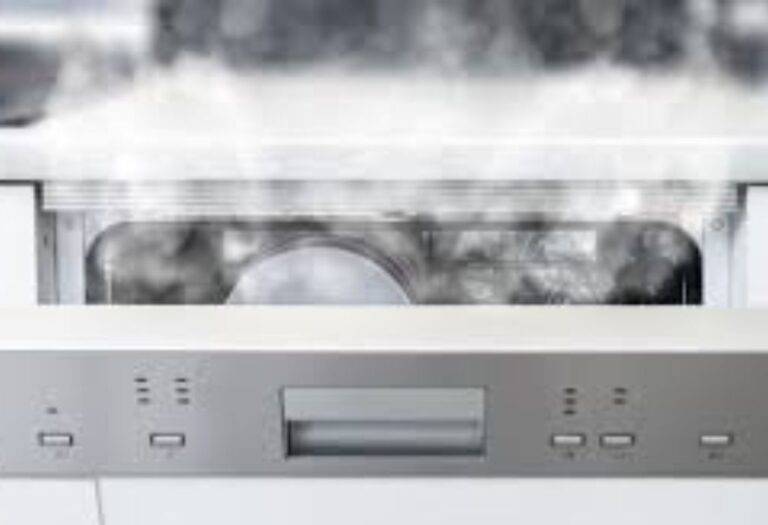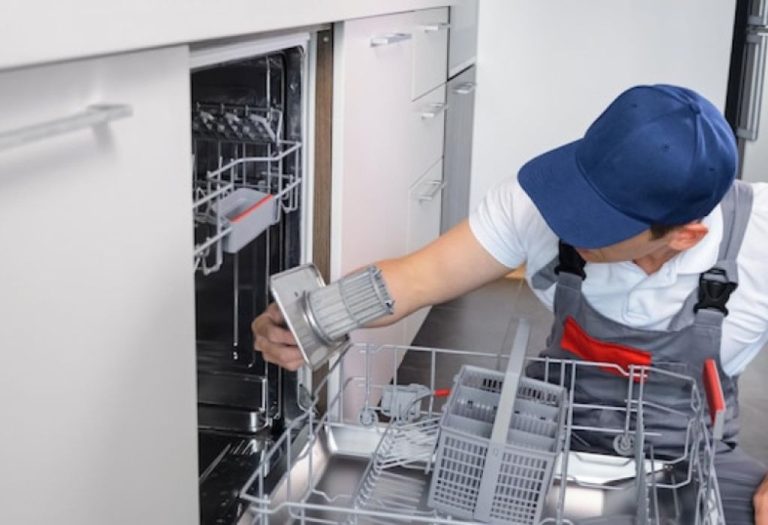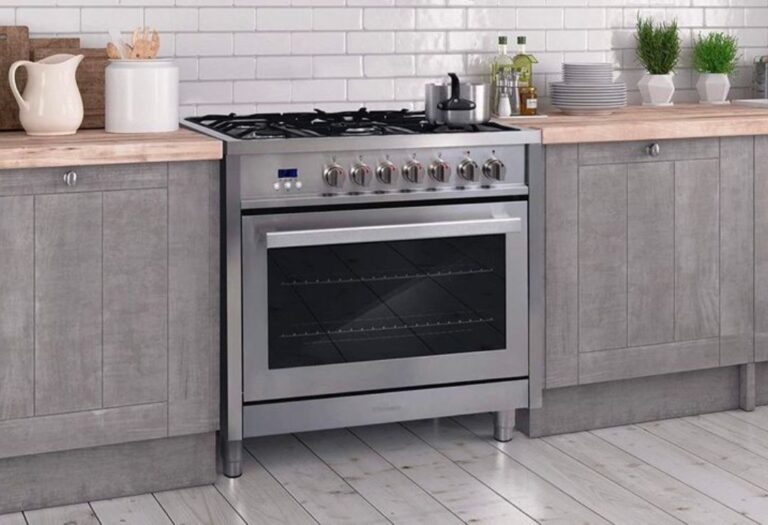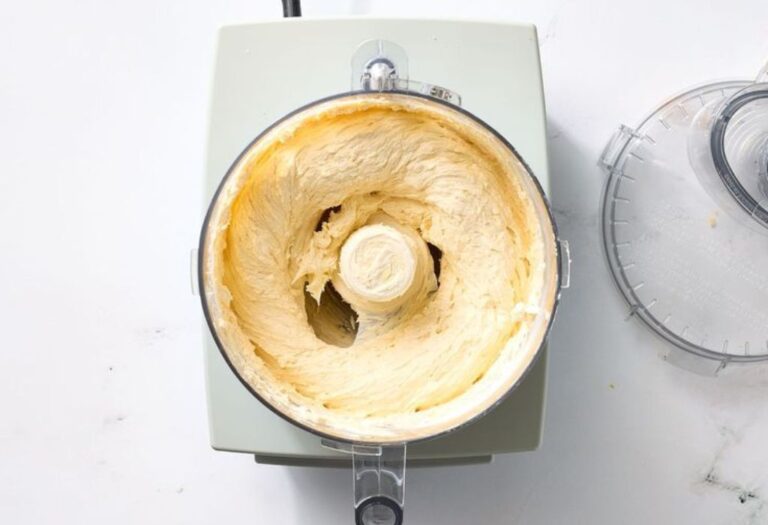A favorite ceramic pan often tells a story of countless meals, but stains can quickly turn that story into frustration. Brown spots, burnt-on residue, and discoloration make cookware look old and unattractive.
Stains are more than a cosmetic issue. They can interfere with cooking performance and even shorten the lifespan of ceramic coatings if not treated properly.
Many cooks wonder if restoring stained cookware requires harsh chemicals or expensive products. The curiosity lies in discovering that everyday items like baking soda and white vinegar can make a real difference.
The benefit is clear. By learning how to remove stains from ceramic cookware, one can restore shine, protect the non-stick surface, and avoid unnecessary replacements.
Statistics show that ceramic cookware continues to grow in popularity, with global demand rising by nearly 6% annually due to its health-conscious appeal (source). At the same time, cleaning experts emphasize that gentle, natural methods are the safest way to maintain ceramic coatings (source).
The contrast between stained cookware and its original polished surface creates an urgency to act. Stubborn marks are not permanent, but they demand the right approach.
What Makes Ceramic Cookware Stain… and How to Prevent It
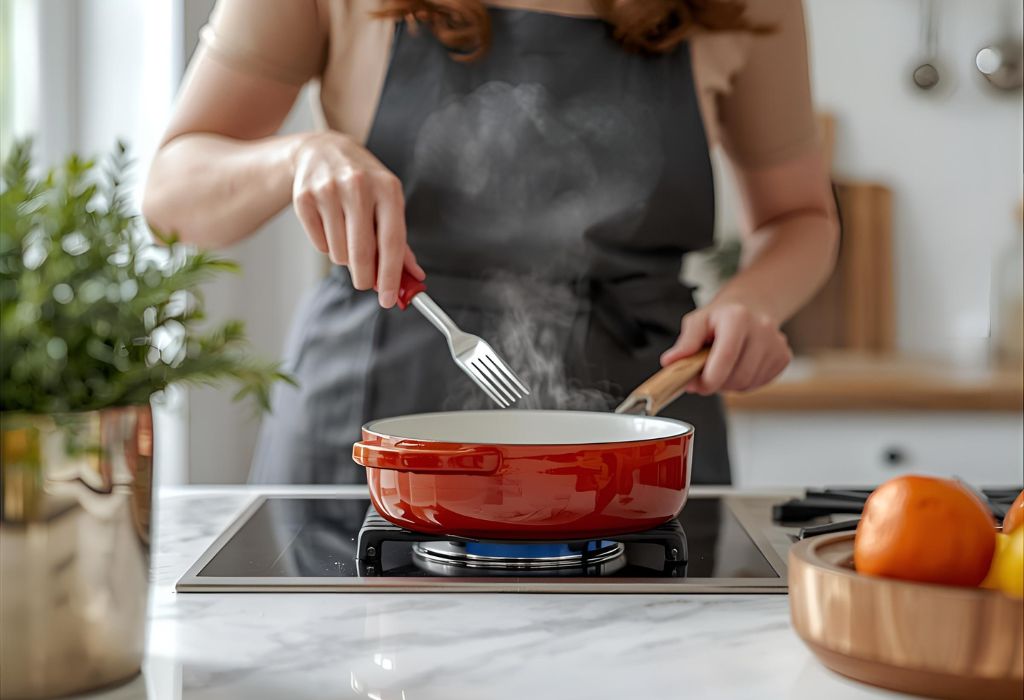
Ceramic cookware is loved for its glossy finish and non-stick performance, yet stains appear quickly when the surface is exposed to daily cooking. Light-colored coatings reveal every trace of oil, residue, and discoloration more easily than darker alternatives.
The primary cause of stains is carbonized oil. When oil is heated past its smoke point, it burns and leaves behind a brown or black film that clings tightly to the ceramic surface. Over time, these deposits build up and create stubborn marks that resist ordinary washing.
Cooking at high temperatures also accelerates staining. Ceramic pans are designed for low to medium heat, but many home cooks mistakenly expose them to intense heat that weakens the non-stick layer and allows residue to bond more strongly.
Another contributor is the use of aerosol cooking sprays. These sprays contain additives that do not burn off completely, leaving behind sticky residues that form hard-to-remove stains. Gentle oils like avocado or olive oil are better suited for ceramic coatings.
Improper cleaning habits play a role as well. Leaving food residue in the pan overnight or attempting to scrub with abrasive pads only worsens the problem. Scratches invite deeper staining, while neglect allows discoloration to settle into the coating.
Prevention begins with mindful cooking and careful cleaning. Using the right oils, avoiding high heat, and hand-washing immediately after use keeps the ceramic surface in pristine condition. With consistent care, stains can be minimized before they become permanent.
Essential Gentle Tools & Ingredients for Stain Removal
The secret to restoring stained ceramic cookware does not lie in harsh chemicals but in simple pantry staples. Everyday ingredients like baking soda, white vinegar, and hydrogen peroxide have natural cleaning powers that work without damaging the coating.
Baking soda is one of the most effective options. Its fine particles act as a mild abrasive, powerful enough to lift stains but gentle enough to protect the ceramic surface from scratches. When combined with water or vinegar, it forms a paste that targets discoloration directly.
White vinegar provides another layer of cleaning strength. Its natural acidity dissolves burnt-on residue and loosens grease that clings to ceramic surfaces. Used in combination with baking soda, vinegar creates a fizzing reaction that lifts stains more efficiently.
Hydrogen peroxide offers a safe bleaching effect. It brightens discoloration, tackles stubborn brown patches, and revives the original glossy appearance of ceramic pans. Unlike bleach, it cleans without leaving harmful residues behind.
The right tools matter just as much as the right ingredients. A soft sponge, microfiber cloth, or nylon brush ensures stains are removed gently. Steel wool or abrasive scrubbers should be avoided because they can scratch the coating and cause long-term damage.
Gentle dish soap also plays a key role in stain removal. It cuts through grease without stripping the surface. Paired with warm water, it helps loosen residue before deeper cleaning methods are applied.
By relying on natural cleaners and non-abrasive tools, it becomes possible to tackle tough stains effectively while preserving the life of ceramic cookware. These essentials form the foundation for every safe cleaning method that follows.
Step-by-Step: Remove Stains from Ceramic Cookware
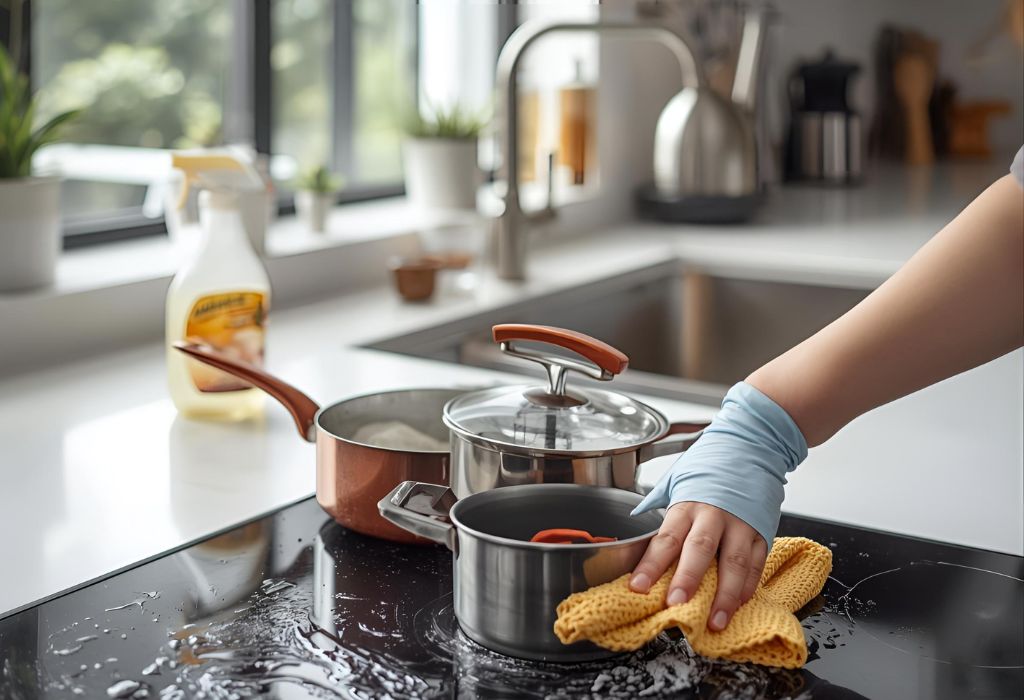
Cleaning stained ceramic cookware begins with patience and the right approach. The process is not complicated, but skipping steps often leads to frustration and incomplete results.
The first step is preparation. Allow the pan to cool completely before cleaning to avoid sudden temperature changes that could damage the coating. Place the cookware on a stable surface and remove any loose food particles with warm water and a soft sponge.
Next comes the baking soda method. Create a thick paste by mixing baking soda with water or white vinegar. Spread the paste directly over the stained areas and let it sit for at least 15 minutes. This contact time allows the natural abrasives and acids to break down stubborn residue.
Once the paste has set, scrub gently with a soft sponge or microfiber cloth. Small circular motions help lift the stain without scratching the ceramic finish. Rinse thoroughly with warm water to reveal a cleaner surface.
For tougher stains, simmering is effective. Fill the pan with water, add a few tablespoons of vinegar, and heat on low for several minutes. The gentle boil loosens burnt-on food and carbonized oils, making them easier to wipe away.
Hydrogen peroxide is another option for discoloration that refuses to budge. Pour a thin layer over the stained area and let it sit for 30 minutes. The peroxide penetrates the residue and brightens the surface before rinsing.
Finish the process with a standard hand wash. Use gentle dish soap and warm water, rinse carefully, and dry the pan immediately with a soft towel. This step prevents water spots and ensures the cookware is ready for its next use.
By following these methods in sequence, ceramic cookware can be restored to its original glossy state without the risk of scratches or damage. Consistency in cleaning makes the results last longer and keeps the surface looking new.
Additional Techniques & Deep-Clean Options
Sometimes stains remain even after standard cleaning methods. These deep-set marks require stronger approaches, but they can still be tackled safely with the right techniques.
Cream of tartar is a surprisingly effective option. When mixed with water into a thick paste, it provides a gentle abrasive action that helps lift stubborn discoloration without scratching ceramic surfaces. Applying it directly to stains and leaving it for 15 minutes enhances its effect.
Melamine sponges, often known as “magic erasers,” offer another solution. They work by lightly buffing away surface stains, but they should be used carefully and sparingly to avoid dulling the glossy finish. A light hand and gentle pressure are enough to make a difference.
Hydrogen peroxide remains one of the most versatile deep-cleaning agents. For severe discoloration, combining it with baking soda creates a foaming mixture that penetrates burnt-on layers and restores brightness. This method is best reserved for occasional use rather than daily cleaning.
Some cooks also revive cookware by applying a light seasoning. A thin coat of neutral oil rubbed into the ceramic surface and heated on low helps restore the slick texture and adds a subtle protective layer. This technique is not mandatory but can extend the life of non-stick properties.
Knowing when to stop is just as important as knowing how to clean. If stains persist despite multiple safe attempts, it may be a sign that the ceramic coating has degraded beyond repair. Replacing the pan at this stage ensures safer cooking and better results.
By combining these advanced methods with routine care, ceramic cookware can be kept in excellent condition even after years of use. The key is balancing effectiveness with caution to avoid damaging the coating while achieving a spotless finish.
How to Maintain & Protect Your Ceramic Cookware for the Long Term
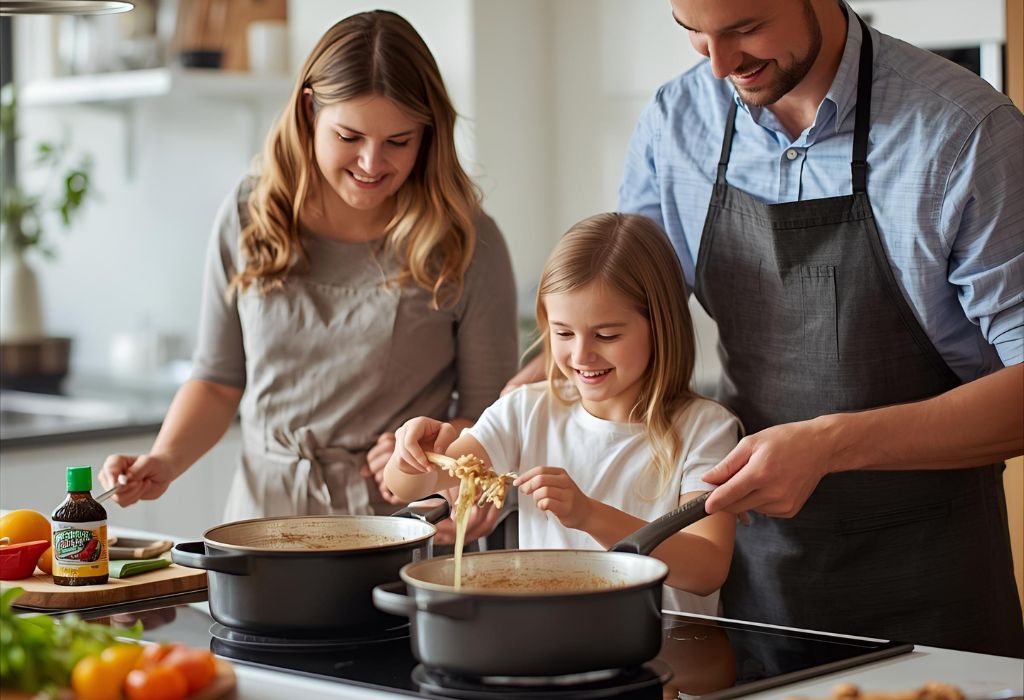
Removing stains is only part of the process. The real goal is to keep ceramic cookware clean, glossy, and functional for as long as possible. Proper maintenance ensures that stains do not return quickly and that the non-stick surface stays intact.
The most important habit is cooking on low to medium heat. Ceramic coatings are not designed for intense temperatures, and high heat accelerates staining, weakens the surface, and reduces overall performance. Gentle heat preserves both the appearance and the longevity of the pan.
Utensil choice also plays a major role in protection. Wooden spoons, silicone spatulas, and nylon tools are ideal for ceramic surfaces. Metal utensils should be avoided because they scratch the coating, allowing future stains to penetrate more deeply.
Storage is another factor often overlooked. Stacking ceramic pans without protection leads to scratches and dulling of the finish. Using pan protectors, soft cloths, or hanging cookware on hooks prevents unnecessary wear and keeps each piece looking new.
Hand washing remains the safest cleaning method. Dishwashers expose ceramic coatings to high heat and harsh detergents that gradually erode the non-stick layer. Gentle dish soap, warm water, and a soft sponge provide a more effective and protective alternative.
Occasional seasoning can also extend cookware life. Applying a thin layer of neutral oil and heating the pan on low restores a slick surface that reduces staining and improves cooking performance. This simple routine adds a layer of defense against stubborn residue.
By adopting these habits, ceramic cookware can remain in excellent condition for years. Prevention, care, and mindful use ensure that stains are less frequent, cleaning is easier, and every meal is prepared in pans that look as good as new.
Conclusion
Stains on ceramic cookware may seem permanent, but the right techniques prove otherwise. Simple ingredients like baking soda, vinegar, and hydrogen peroxide restore the surface without causing harm to the non-stick coating.
Regular care is just as important as stain removal. Cooking on gentle heat, avoiding harsh tools, and hand washing consistently keep ceramic pans looking newer for longer.
Deep-cleaning methods such as cream of tartar paste or light seasoning add extra protection, ensuring the glossy finish stays intact even after heavy use. Knowing when to replace cookware also helps maintain both safety and cooking performance.
By learning how to remove stains from ceramic cookware and applying preventive habits, every kitchen can enjoy pans that look polished, perform well, and last for years. The best results come from combining simple routines with mindful care, ensuring every meal is cooked in clean and reliable cookware.
I’m Emma J. Caldwell, the founder, lead writer, and home-cooking enthusiast behind KitchenGuideCo.com. With a background in culinary arts and over a decade of cooking experience in both professional and personal kitchens, I created this platform to demystify recipes, offer smart kitchen gadget reviews, and guide readers through meal prep with confidence and clarity.


